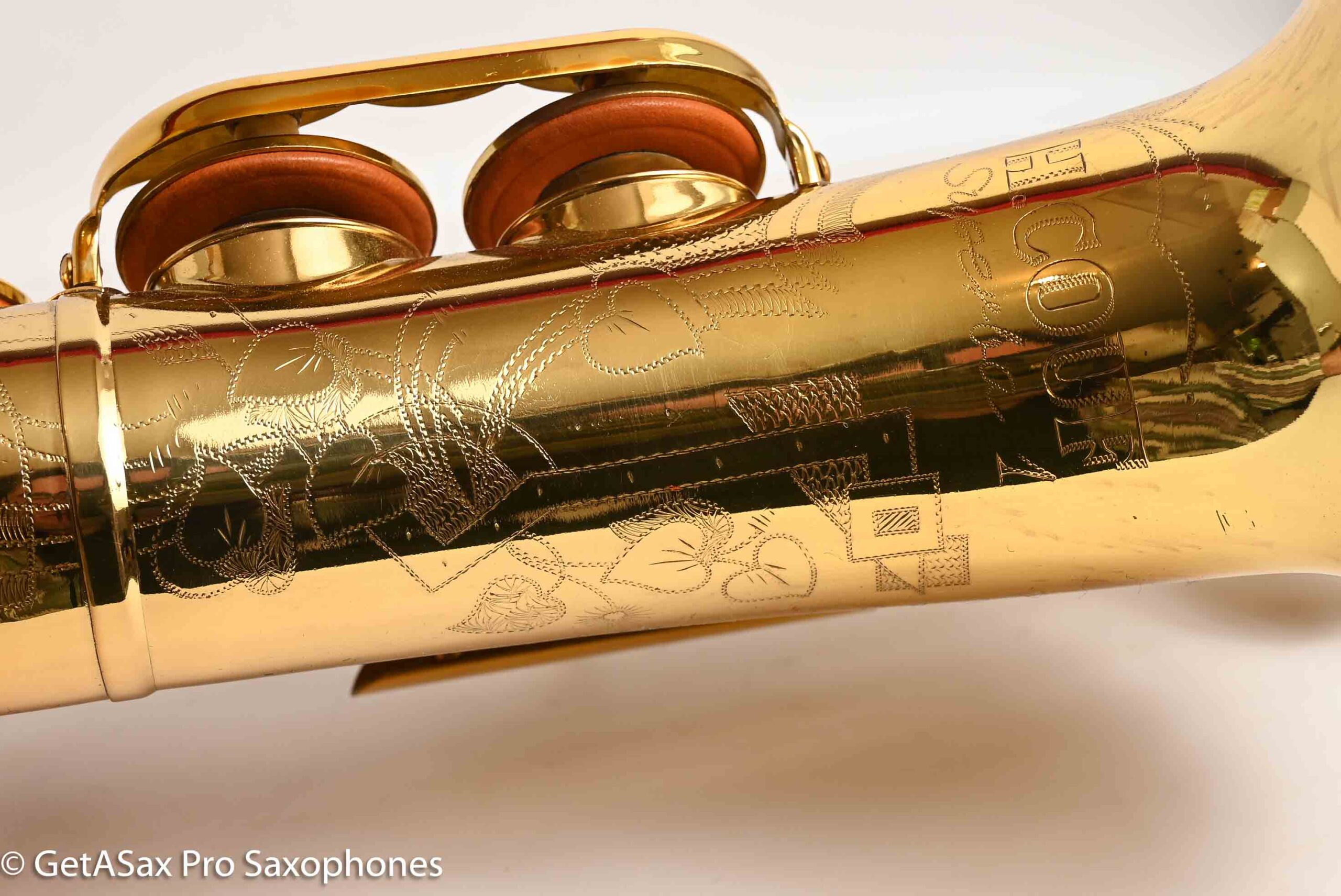| Superba I » | Superba II » | H. Couf Serial # Chart |

What really are the differences between the Superba I and Superba II Couf alto saxophones? The short answer is not as much as you might think, and it all depends on when it was made.
H. Couf altos did undergo changes over the approximately 22 years that they were produced. It does appear that the earliest horns shared more with their JK cousins than latter horns did—as you will see below.
A quick disclaimer
Unlike the Selmer Mark VI alto—that had some very well documented changes to its bow over horn’s production run—very little is known at this point about the H. Couf saxophone’s design changes. To the best of my knowledge, the research I have gathered here is the first real attempt at collating relatively large amounts of data about this J. Keilwerth-made saxophone brand.
However, there are a number of limitations with this data: 1. The data gathered is based only on what can be seen in photos I have managed to find scattered across the Internet—or in a very few cases in person. 2. The quality and quantity of photos is often very limited for each instrument (sample). 3. Any changes not visible to the naked eye—such as bore dimensions for example—are obviously not known. 4. In some cases the sample sizes that I have been able to gather to date are so small, that I haven’t been able to conclusively draw any conclusions.
For all these reasons this page continues to be a work in progress. Over time, my hope is to fill in the missing blanks. If you can help in some way, please do not hesitate to drop me a note. Thanks!
What does the term “intermediate” mean in Couf speak?
Herb Couf said:
There were three levels of H. Couf saxophones; Superba I, the professional line…. Superba II the intermediate line with many of the same features as the Superba I…
Source: Saxophone: Ein Kompendium, Uwe Ladwig. Second Edition, 2012. p. 59
That said, “intermediate” does not mean inferior, and not up to pro standards. The Superba II were built to the same level of precision that their Superba I cousins were. All intermediate means in this case, is that a few minor things were different. (Much like the only difference between JK’s pro and intermediate Toneking and The New King was the presence and absence of a high F# key.)
What’s interesting about the Superba IIs, is that that model doesn`t follow the same neat evolutionary trajectory that the Superba 1/I does. Why? Since H. Couf has passed away I’m not sure we will ever truly know for sure. And unless someone invents a time machine and we can go back and talk to the man himself, we likely never will.
With all that in mind, it’s time to take a closer look at what makes a I a I, and a II a II, and their various phases and features.
Superba I Phases & serials
serial # range catalogued to date: 51363 – 56781
serial # range catalogued to date: 65736 – 76761
serial # range catalogued to date: 78786 – 81936
serial # range catalogued to date: 81991 – 91160
Superba II Phases & serials
serial # catalogued to date: 56462
serial # catalogued to date: 67475
serial # range catalogued to date: 72917 – 76109
serial # range catalogued to date: 79923 – 82516
A quick and dirty overview chart of the differences between the Superba 1 & 2 alto saxophones
Why is this quick and dirty? Because it doesn’t account for the various exceptions to the features outlined in it—and there are quite a few. These exceptions, and much, much more, are gone over in minute detail in the following Superba 1 & 2 pages. So think of this chart as a primer, or a review, if you’re looking for a simple broad strokes listing of what changed when.
Superba 1 vs 2 altos
Feature | Superba 1/I | Superba 2/II |
|---|---|---|
G# Key | Phase 1-2 black plastic. Phase 3-4 MOP. | Phase 1-3 black plastic. Phase 4 MOP |
Bell to body brace | Circle & 1/2 oval | Single round metal bar that for Phase 3-4 is shaped around the hinge tubes. |
Clothes guard | Phase 1 Lucite, Phase 2-4 metal | Phase 1 Lucite, Phase 2-4 metal |
Lyre holder | Attached to socket opposite neck fastening screw | Left side of body tube beside F3 key |
MOP keys | Larger, without metal edges. (Like what`s now on the SX90.) | Smaller button inset within brass "cup". Metal edges encircle the pearls. |
Right pinkie keys | "New", round JK style | Phase 1 & 2 Old-school JK style. Phase 3-4 "New", rounder JK style. |
High F# key | Phase 1-2 small key shaped like R palm keys. Phase 3-4 semi-oval, MOP | Phase 1-3 looks like & is where JK Toneking's was. Phase 4 semi-oval, MOP. |
Chromatic F# | Phase 1-2 On side of body. Small key shaped like right palm keys. Phase 3-4 On back of body tube. MOP button key | Phase 1 on side of body tube. Looks like JK Toneking's. Phase 2-3 On side of body tube with a MOP button key. Phase 4 on back of body tube with MOP button key. |
Right thumb rest | Phase 1-3 Adjustable metal. Phase 4 fixed black plastic. | Fixed metal |
Strap ring | Thick, flat ring | Simple metal ring |
Tone holes | Rolled | Phase 1 rolled. Phase 2-4 drawn & straight. |
Engraving | Bell & bow | Bell |



You must be logged in to post a comment.